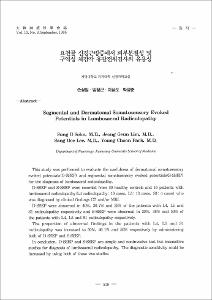요천골 신경근병증에서 피부분절성 및 구역성 체감각 유발전위검사의 유용성
- Keimyung Author(s)
- Sohn, Sung Il; Lim, Jeong Geun; Yi, Sang Do; Park, Young Chun
- Department
- Dept. of Neurology (신경과학)
- Journal Title
- 대한신경과학회지
- Issued Date
- 1995
- Volume
- 13
- Issue
- 3
- Abstract
- This study was performed to evaluate the usefulness of dermatomal somatosensory evoked potentials(D-SSEP) and segrnental somatosensory evoked potentials(S-SSEP) for the diagnosis of lurnbosacral radiculopathy.
D-SSEP and S-SSEP were recorded from 30 healthy controls and 16 patients with lumbosacral radiculopathy(LA radiculopathy: 10 cases, L5: 13 cases, SI: 4 cases) who was diagnosed by clinical findings CT and/or MRI.
D-SSEP were abnormal in 40%, 30.7% and 25% of the patients with IA, L5 and Sl radiculopathy respectively and S-SSEP were abnormal in 20%, 38% and 50% of the patients with IA, L5 and Sl radiculopathy respectively.
The proportion of abnormal findings in the' patients with L4, L5 and Sl radiculopathy was increased to 50%, 46. 1% and 50% respectively by administering both of D-SSEP and S-SSEP.
In conclusion, D-SSEP and S-SSEP are simple and noninvasive test but insensitive studies for diagnosis of lumbosacral radiculopathy. The diagnostic sensitivity could be increased by usmg both of these two studies.
저자는 요천골 신경근병증의 전기생리학적 진단에 있어서 D-SSEP와 S-SSEP의 유용성을 알아보기 위하여 본 연구를 시행하였다. 검사대상으로서는 임상적으로 요천골 신경근병증이 의심되고 전산화단층촬영이나 자기공명영상에서 요천골 신경근의 병변이 관찰된 자로서 병력과 신경학적 검사상 중추신경계 장애의 병력이 없으며, 신경전도 검사상 말초성 다발성신경병증이 없는 16례와 정상대조군 30례를 대상으로 하여 D-SSEP와 S-SSEP를 시행하여 다음과 같은 결과를 얻었다.
정상대조군에서 L4, L5 및 S1의 D-SSEP의 첫 번째 양성파인 P1의 평균잠복시간은 각각 42.8±3.65msec, 47.4±4.13msec 및 47.4±3.29msec였고 평균진폭은 각각 0.58±0.33㎶, 0.72±0.43㎶ 및 0.59±0.39㎶였으며 좌우측 잠복시간 평균차이는 각각 1.82±1.22msec, 2.06±1.51msec 및 2.09±1.71msec였다. 정상대조군에서 L4, L5 및 S1의 신경근을 나타내는 복재신경, 표재비골신경 및 비복신경을 각각 자극시 얻은 S-SSEP의 P1 평균잠복기간은 각각 40.3±2.97msec, 42.7±3.80msec 및 43.7±2.99msec였고, 평균진폭은 각각 0.68±0.40㎶, 0.74±0.57㎶ 및 1.01±0.65㎶였고, 좌우측 잠복시간 평균차이는 각각 2.55±1.93msec, 2.04±1.53msec 및 2.33±2.05msec였다.
요천골 신경근병증을 가진자에서 D-SSEP에서 이상소견을 보인 빈도는 L4, L5 및 S1 신경근병증에서 각각 40%, 30.7%, 및 25%였고 S-SSEP에서 이상소견을 보인 빈도는 각각 20%, 38%, 및 50%였다. 두검사중 어느 한 검사이상에서 이상소견을 보인 빈도는 L4, L5 및 S1에서 50%, 46.1% 및 50%였다. 그러므로 D-SSEP와 S-SSEP는 간편하고 비관혈적인 전기생리학적 검사방법이나 요천골 신경근병변의 진단민감도가 낮음으로 요천골 신경근병변의 진단에 있어서 그 유용성이 적으며 두 검사를 병용함으로서 진단에 다소 도움을 줄 수 있을 것으로 생각된다.
- Alternative Title
- Segmental and Dermatomal Somatosensory Evoked Potentials in Lumbosacral Radiculopathy
- Publisher
- School of Medicine
- Citation
- 손성일 et al. (1995). 요천골 신경근병증에서 피부분절성 및 구역성 체감각 유발전위검사의 유용성. 대한신경과학회지, 13(3), 519–527.
- Type
- Article
- ISSN
- 1225-7044
- Appears in Collections:
- 1. School of Medicine (의과대학) > Dept. of Neurology (신경과학)
- 파일 목록
-
-
Download
 oak-bbb-1698.pdf
기타 데이터 / 5.92 MB / Adobe PDF
oak-bbb-1698.pdf
기타 데이터 / 5.92 MB / Adobe PDF
-
Items in Repository are protected by copyright, with all rights reserved, unless otherwise indicated.